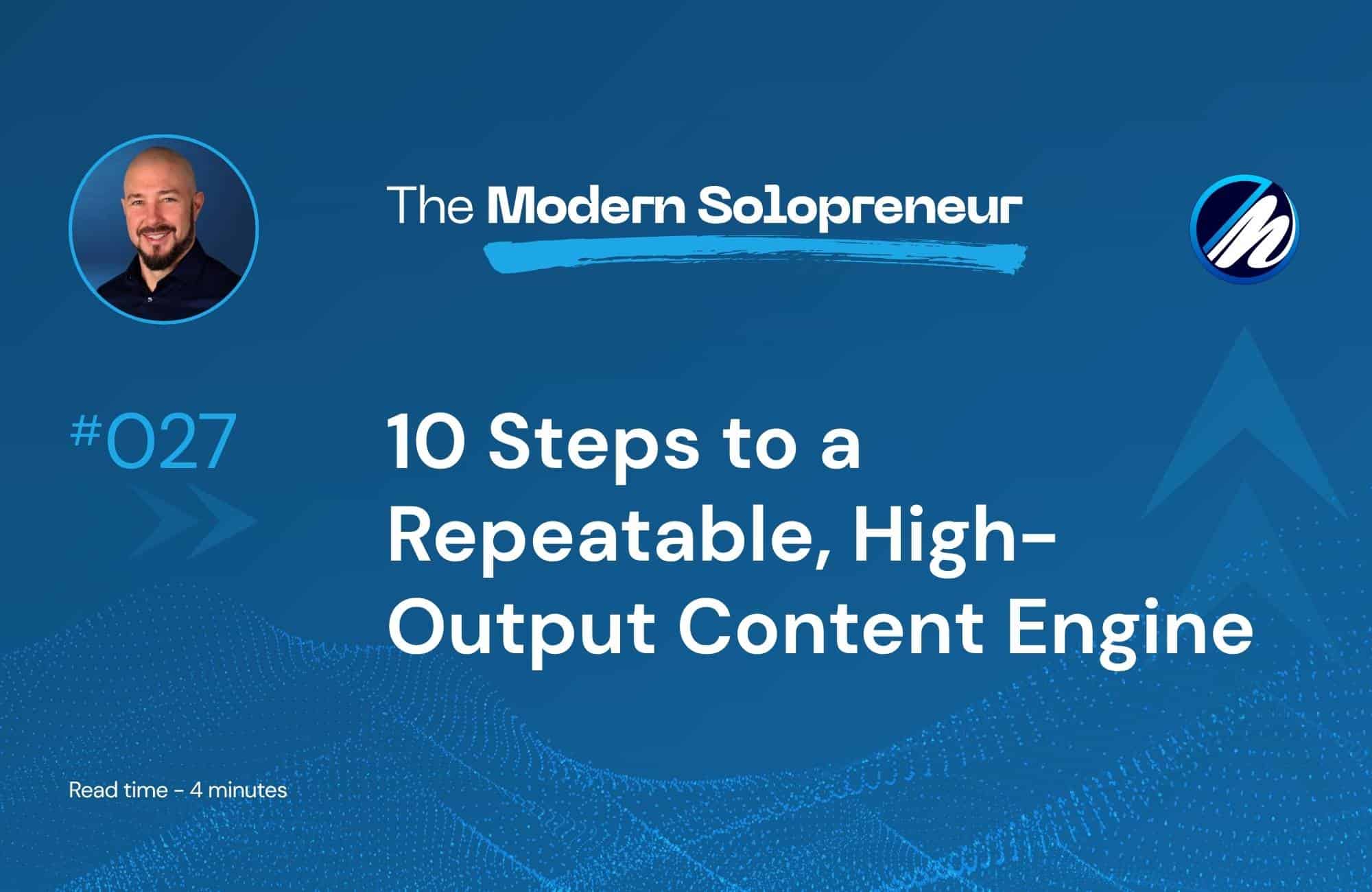Read time: 4 minutes
You’re posting. You’re trying to be consistent.
But it still feels random, exhausting, and disconnected from your business — and from the results you actually want.
The problem?
You don’t have a system.
You have a to-do list.
This guide will show you how to build your first content engine—a lightweight, repeatable structure that helps you create consistently, grow strategically, and compound trust over time.
You don’t need to go viral. You don’t need to post every day.
You just need a strategy you can stick to.
Let’s dive in.
Unfortunately, most creators fall into one of two traps:
- Post often, with no focus — then burn out
- Overthink, then never post — then stall out
Why You Need a Content Engine (Not Just More Content)
A content engine fixes both. It gives you:
- A rhythm you can keep
- A container that runs your ideas through a repeatable process
- A way to reuse and repurpose without reinventing
Content engines build leverage — they turn time spent into assets that keep working.
They work with your schedule, not against it.
Introducing the 1-3-1 Content Engine
Your 1-3-1 Engine is the solo operator’s content system — built for consistency, leverage, and control.
It runs on a simple rhythm:
- 1 Core Idea per Week — drawn from real audience problems
- 3 Content Pieces from That Idea — built for reach, depth, and proof
- 1 Weekly Block to Batch + Schedule — the system that keeps it all running
Behind this rhythm is a full 10-step framework that turns one insight into a week of strategic, compounding content.
Let’s walk through how it works.
⚙️ PHASE 1 — Fuel the Engine
(Steps 1–3)
Your engine only works if it has real fuel — problems your ICP actually feels. You’re not starting from ideas; you’re starting from evidence.
1️⃣ Audit Your Raw Material
Mine what already exists:
- Old posts, replies, newsletters, DMs, client notes.
- Anywhere your audience talks about their pain.
You’re not brainstorming — you’re hunting for the line that makes your ICP say:
“That’s exactly what I’m stuck on.”
Save every hit in a Notion column called Audience Problems. Each one’s a future core idea.
2️⃣ Select One Profitable Theme
Pick the problem that ties most directly to:
- A belief you challenge or reinforce
- An offer you help solve it with
Every weekly theme should connect back to your business engine, so content becomes leverage, not noise. If you could DM someone help for that problem today → it’s the right one.
3️⃣ Define Your Headline Insight
Distill the theme into a single sharp line — your flagship belief.
Examples:
“Most creators post too much and say too little.” “Consistency doesn’t matter if you’re being forgettable.”
It’s short, specific, and slightly contrarian — the gravity point for every post that week.
✅ End of Phase 1 Output:
- Real audience problems cataloged
- One weekly theme aligned to your offer
- Headline insight to anchor the week
Your engine now has fuel based on proof, not guesses.
⚙️ PHASE 2 — Generate Output
(Steps 4–6)
Now that you’ve got fuel, it’s time to turn ideas into output — fast, clean, and consistent.
4️⃣ Draft the Flagship Post
Start with your headline insight and expand it into one post that teaches or challenges. This is your anchor — the message that shows authority and earns saves.
Keep structure simple: Hook → Story or Proof → Insight → Action Line. You’re building clarity, not hype.
5️⃣ Create Two Derivative Angles
Spin your flagship into two supporting pieces:
- A micro-story (how you learned it)
- A quick tip or process (how to apply it)
You now have three assets hitting the same belief from different angles — repetition that feels fresh.
6️⃣ Add an Amplifier Format
Multiply reach by shifting one post into a new format:
- Turn the flagship into a carousel, short clip, or newsletter section
- Keep the core line intact
This gives the same message new distribution — without new effort.
✅ End of Phase 2 Output:
- 1 flagship post that drives authority
- 2 derivatives that deepen resonance
- 1 amplifier format that extends reach
This is your weekly content multiplier — one idea, many touchpoints.
⚙️ PHASE 3 — Systemize Production
(Steps 7–9)
This is where consistency turns into leverage. You’re not creating — you’re installing a system.
7️⃣ Batch in One Block
Set a 60–90-minute block each week to:
- Pick your weekly theme
- Draft your 3 posts
- Queue them for publishing
This single block locks consistency, focus, and freedom. No more daily scramble.
8️⃣ Pre-Schedule & Tag by Theme
Schedule everything in advance. Tag each post to a topic pillar, not for tracking — but to ensure full topic coverage across the month. You’ll instantly see what ideas need sharpening or expanding.
9️⃣ Log Performance Metrics
At week’s end, log basic signals: reach, saves, replies. No over-analysis — just enough to spot what hits. The engine learns as you go.
✅ End of Phase 3 Output:
- Repeatable 90-minute workflow
- Clear topic coverage map
- Feedback loop that improves each cycle
Your content now runs on rhythm, not willpower.
Ready to put your new engine to work?
🔥 ONE OFFER PLAYBOOK
PRE-RELEASE OFFER
🧭 You’ve built your content engine—now let’s connect it to the offer that powers it.
I’m releasing the 1-Offer Playbook soon — the framework to turn one validated idea into a clear offer, a simple funnel, and a content strategy that drives clients straight to it.
Join the waitlist today and be among the first 20 people to get lifetime access free — a $450 value.
